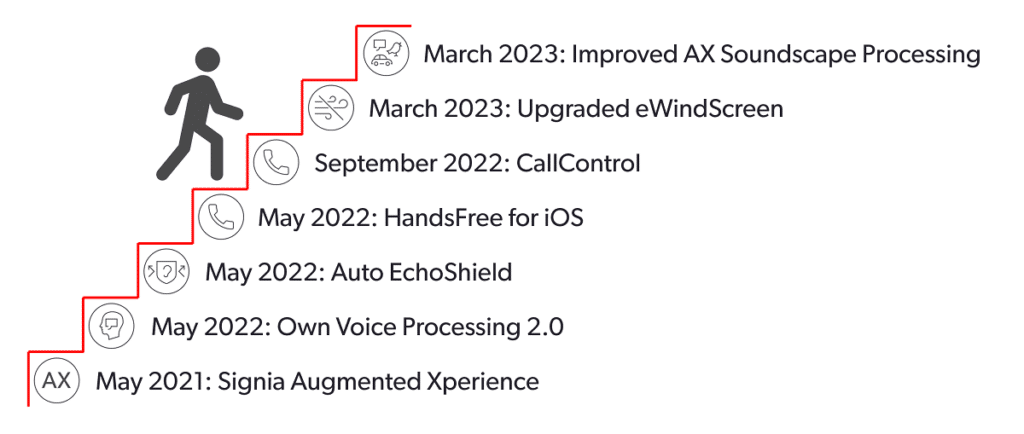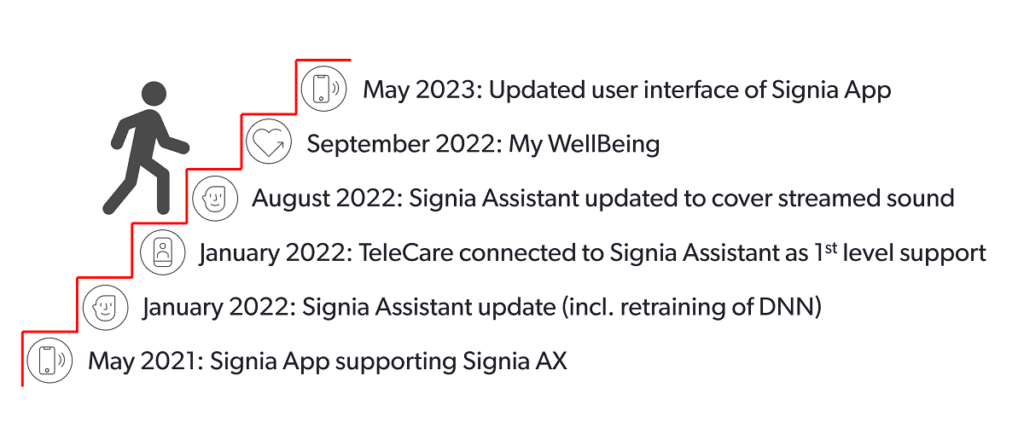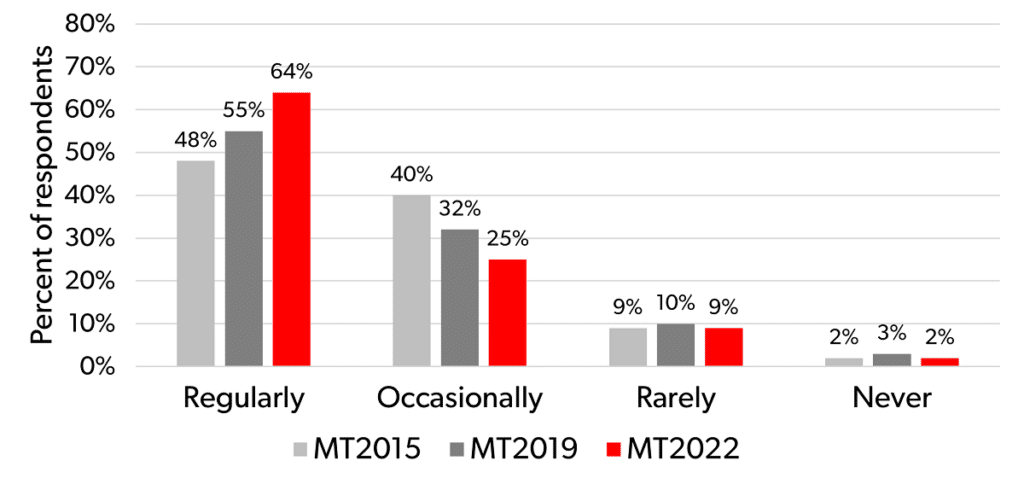The benefits of this new generation of hearing aids requires a deeper level of collaboration through firmware and software.
By Brian Taylor, AuD, and Niels Søgaard Jensen, MSc
Technology, which not long ago was found only on smartphones and other consumer electronic devices, is now commonly available on many prescription hearing aids. This new generation of hearing aids includes periodic firmware updates and smartphone-based apps. MarkeTrak 2022 survey data suggests this convergence of technology might be driving better quality of life outcomes for many individuals.
The convergence of hearing aids and consumer electronic
Until recently, hearing aids and consumer electronic devices existed as completely separate product categories. However, everything began to change when the first hearing aids with direct Bluetooth streaming became commercially available. How did this occur? Gradually, then suddenly, as Ernest Hemingway said. As illustrated in Figure 1, a broad range of technology, historically confined to consumer electronic devices, has swiftly found its way into prescription hearing aids. This article examines how two common technologies associated with this convergence, firmware updates and apps, might be driving quality-of-life improvements for some hearing aid wearers.

Firmware updates
Look around your office or home; you will likely see several devices requiring firmware. Your smartphone, laptop, internet router, printer—even your favorite new kitchen appliance, might require periodic firmware updates. Modern hearing aids are no different.
So, what is firmware, and why is it important for wearers to get the firmware of their hearing aids updated? To better understand the importance of firmware updates on hearing aid performance, it helps to step back and examine more broadly how firmware has become a routine part of our everyday lives.
Firmware, in basic terms, is a special type of software embedded in a piece of hardware. Think of firmware as a set of instructions or code that modern devices of all types need to perform their functions. Firmware updates are an integral part of the digital world. Manufacturers of many modern devices regularly create updated firmware. For example, if you drive a newer car, you’ve probably gotten an email or text from the dealership asking you to schedule an appointment for a firmware update—an update that will improve the performance of the transmission, exhaust system, or some other integral part of the car’s operating system. Any of these firmware updates are designed to fix bugs or improve the performance of features in the operating hardware of the device.
Firmware in hearing aids
Like other modern devices in the digital era, the firmware embedded within a hearing aid controls how the hearing aid functions. Since the advent of wireless Bluetooth streaming, specifically with made-for-iPhone hearing aids around 2014, it is common for hearing aids to require periodic firmware updates. New firmware updates may contain product improvements in the form of completely new features and upgrades to existing features.
The firmware update of the hearing aids is normally completed by connecting them to the fitting software. Consequently, for the wearer to get the update, they must return to the clinic for an in-person appointment to receive it. The bottom line is that when a new version of firmware is available for a particular hearing aid, people who wear that hearing aid should receive the update so they can benefit from the improved performance.
Signia’s approach to firmware updates
Firmware updates are an effective way to deploy new features, enhancements to sound-processing algorithms, and improved functionality for already-existing hearing aids, as these new features become available without additional costs to the wearer. Figure 2 illustrates a timeline of recent Signia firmware updates of the Signia Augmented Xperience (AX) platform and the new features associated with each firmware update.

In May 2021, Signia launched Signia AX, which introduced an innovative signal processing algorithm called Augmented Focus.1 Using its novel approach to beamforming, Augmented Focus splits incoming sounds into two streams and processes each stream independently of each other. This results in remarkable improvements in the SNR.2
Auto EchoShield and Own Voice Processing 2.0
In May 2022, Signia upgraded two existing industry-first features.3 Auto EchoShield constantly analyzes the level of reverberation in any situation and then automatically adjusts the sound processing, allowing the wearer to focus on critical speech cues. Own Voice Processing 2.0 harnesses the split processing capability of the Augmented Xperience platform to process the wearer’s own voice separately from simultaneous ambient sounds, allowing wearers to speak comfortably and confidently without being bothered by the sound of their own voice or distracted by ambient sounds.
AX HandsFree and CallControl for iOS
With firmware updates in the spring and fall of 2022, Signia was able to add hands-free calling to its line of products. In combination, the HandsFree for iOS and CallControl features allow wearers to receive and end calls with their hearing aids, without having to touch their smartphone.4
Upgraded eWindscreen and updated AX SoundScape Processing
The most recent firmware updates to the Augmented Xperience (AX) platform occurred in March 2023 and include an upgraded eWindScreen and improved AX Soundscape Processing.5 These firmware updates provide better protection against annoying wind noise and enable wearers to get even more value out of Own Voice Processing 2.0. In addition, the own voice detection now serves as an intelligent input to the AX Soundscape Processing to provide even better support in situations where the wearer engages actively in communication in challenging sound environments.
Signia’s approach to app updates
While firmware updates are controlled by the hearing care professional, who drives the updating process, apps place most of the control in the hands of the wearer. Like firmware updates, smartphone-based apps provide additional hearing aid functionality with the added ability of real-time tracking for those who want it. Figure 3 outlines several of the recent Signia updates to its app, which are available to Signia AX wearers.

Signia Assistant
Launched in late 2019, Signia Assistant uses machine learning to predict the hearing aid adjustment that best addresses a problem experienced and reported by the wearer. Signia Assistant learns the listening preferences of wearers and is thereby enabled to suggest more precise real-time adjustments that lead to higher acceptance rates.6
My WellBeing
The Signia AX technology platform now includes My WellBeing, a set of features accessible through the Signia App to promote general health. Using the hearing aids’ in-built motion sensor, My WellBeing automatically measures the physical activity level (My Activity) and how many steps the wearer takes each day (My Steps). A recent study7 suggests this feature is accurate and reliable. The app also indicates daily use rates (My WearTime) and measures social activity (My Conversations) via use of the Own Voice Processing technology.8
Quality-of-life benefits linked to apps and other newer features
MarkeTrak (MT) 2022 is the latest version of a recurring survey of hundreds of persons with hearing loss, many of whom are owners of hearing aids. One of the most remarkable findings in MT 2022 is just how often hearing aids are reported to regularly improve the quality-of-life of their wearers. As summarized in Figure 4, these quality-of-life improvements have steadily risen over the past three MarkeTrak reports.9 In 2015, 48% of respondents stated that hearing aids regularly improved their quality of life, and in 2022 this number increased to 64%.

Although indisputable evidence remains elusive, it is reasonable to assume many of these quality-of-life improvements are associated with a new generation of features and app updates, most of which were not widely available in hearing aids just a few years ago. This new generation of hearing aids, for the appropriate candidate, provides additional functionality for their wearers. Added functionality, in turn, leads to higher levels of satisfaction, as evidenced in the MT 2022 report, which showed that wearers with devices using rechargeable batteries, downloadable user-controlled apps, and wireless streamers (for the television or a companion microphone) tend to report higher levels of satisfaction compared to those who do not use these features.9
Given these findings, in order to optimize the outcomes of this new generation of hearing aids, providers would be wise to screen the digital literacy of wearers prior to hearing aid use and—with thorough counseling conducted post-fitting—ensure wearers are mastering the skills needed to optimize these qualities-of-life benefits. Unlocking all the benefits of this new generation of hearing aids requires a deeper level of collaboration between provider and wearer, but for the right candidate has the potential to yield tremendous quality-of-life benefits. HR

Brian Taylor, AuD, is the senior director of audiology at Signia, a division of WS Audiology. Niels Søgaard Jensen, MSc, is the senior evidence and research specialist at Signia, Lynge, Denmark
References:
- Jensen NS, Høydal EH, Branda E, et al. Augmenting speech recognition with a new split-processing paradigm. The Hearing Review. 2021;28(6):24-27.
- Taylor B, Jensen NS. Evidence supports the advantages of Signia AX’s split processing. Signia White Paper. Available at: https://www.signia-pro.com/en/blog/global/2022-06-white-paper-evidence-supports-the-advantages-of-signia-ax-split-processing/. Published June 22, 2022.
- Jensen NS, Pischel C, Taylor B. Upgrading the performance of Signia AX with Auto EchoShield and Own Voice Processing 2.0. Signia White Paper. 2022. Available at: https://www.signia-pro.com/en/blog/global/2022-05-02-upgrading-the-performance-of-signia-ax/.
- Jensen NS, Branda E, Harris S, et al. Preferences with a hearing aid headset mode. The Hearing Review.Published January 12, 2023. Available at: https://hearingreview.com/hearing-products/hearing-aids/psap/preferences-with-a-hearing-aid-headset-mode.
- Signia Upgraded eWindScreen and improved AX Soundscape Processing. Signia Backgrounder. 2023. Available at: https://www.signia-pro.com/en/blog/global/2023-03-backgrounder-ewindscreen-and-soundscape-processing/.
- Jensen NS, Taylor B, Muller M. AI-based fine-tuning: how Signia Assistant improves wearer acceptance rates. Audiology Online.2023;(28555). Available at: https://www.audiologyonline.com/articles/ai-based-fine-tuning-signia-28555.
- Branda E, Jensen NS, Warmuth J. Measuring steps at the ear: how my steps improves accuracy. Signia White Paper. 2022. Available at: https://www.signia-pro.com/en/blog/global/2022-09-whitepaper-my-steps/.
- Jensen NS, Taylor B. Supporting hearing health and general health with My WellBeing. Signia White Paper. 2022. Available at: https://www.signia-pro.com/en/blog/global/2022-09-01-whitepaper-my-wellbeing/.
- Picou EM. Hearing aid benefit and satisfaction results from the MarkeTrak 2022 Survey: Importance of features and hearing care professionals. Seminars in Hearing. 2022:43(4); 301–316.



